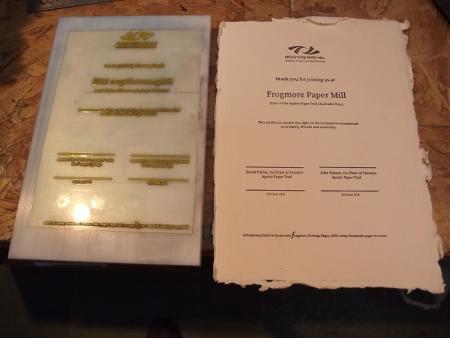Delrin cheaper than an aluminium base
I have been using 20mm Delrin as a base for 152 plates for the past year on the Heidi and a table top and had no problems. The height is slightly under and a bit of card behind brings it up. I have several standing jobs on Delrin so no mucking about peeling plates. They are kept in a dark cabinet so that they don’t harden and curl.

152small.jpg
It’s pretty great material for laser engraving as well, FYI. Imaging delrin for press is a fine way to print.
thanks to are trade wars hobbie steel that is steel for us small quantity users is up 140% this year, Delrin has came down over the years. I did make a base out of it to just to test it worked fine. The only problem I find in production you can cut a mirror like surface on Aluminum the Delrin is hard to cut smooth on the mill you need to find a stock sizes usable. I tried sticking on a .030 piece of PVC to get thickness. shaping to replace chase is a big part of price if you want to go that way also I was unable to put lines that will not clean off on it for setup.
some call it plastic but it is really a durable material made by Dupont to replace steel for gears and bearings.
http://www.eplastics.com/Acetal_Delrin_Sheet
Here’s a good online source for it which carries a wide variety of thicknesses, colors, and sizes. They also do cuts if you specify the size you would like.
Machining, it’s not as difficult to make it flat if you use a high RPM tool and the appropriate cooling mist fluid to mitigate heat and it’s effects. Apparently the use of a facing end-mill works pretty well. You can lightly sand the surface post milling with 600/1200/2000 sandpaper in one direction and then the other with a flat sanding block and you’ll be able to polish it up nicely if you want to go that route, but out of the gate it comes flat enough for my purposes.
As to laser engraving it, it cuts really nicely in my experience running things from bitmap files…… It’s no photopolymer plate but it will allow me to do larger relief prints at a less expensive cost than metal or even wood plates will. Plus it is a solvent resistant material that just doesn’t warp, is very pressure resistant, and it functions nicely for this reason.
What about turning the milled face to the bed? That would give you the factory surface to mount plates on and give you an accurate base height that doesn’t require shimming.
—
Michael Hurley
Titivilus Press
Memphis, TN
with the endogeneity of letterpress people anything can be overcome. like said finding best tool to cut with speed and cooling will help on making. I am a printer by trade making printing related stuff is my hobby or sometimes the other way around.
That is an interesting note on the delrin base. I could not afford a Boxcar base so I bought a piece of aluminum 7/8 thick and 9 x 12. I figured it would fit in the Vandy and the Kluge, which I just got running. It was from Cut2Sizemetals.com. It was not 7/8, but over, probably to allow for working with it. We had joined a MakerSpace mainly for the laser engraver and I thought I would ask if anyone could help mill it down with other tools in the shop. I was surprised someone immediately said they could call a machinist friend! This picture shows the Bridgeport milling machine and the base and the operator, Ryan, who helped. Really decent job using this manual machine. I need to use a little emery cloth on it, but I have tested it and it seems great.
But with the cost of metals going up, I may have to buy a delrin base. I plan on having a few smaller ones. For the Vandy, we are making a 3/4” plywood one with 1/8” acrylic sheet on top. Size 18”X24”. The wood is laser engraved with a grid pattern. I hope it is decent, but may not be as good as the aluminum base, probably sufficient for cuts engraved in thin wood, or any collograph material, or ink wipes..I will certainly try the polymer.
Bridgeportmillingbase.jpg
To get triffic’ flat surfaces by hand one can pinch an idea from the old stone litho days. Stones always were bought and lived as pairs, and the reason was that to grind off an old job, but keep the dead flatness, one placed the two stones face to face with water and grit between, and spun and slid the two against each other. The bumps and hollows on each cancelled (wore away) each other, result dead flat. It did indeed work, I’ve done it many times. So with Delrin, maybe perhaps two sheets of emery stuck back to back, and then two bits of Delrin push to and fro and round and round etc etc …